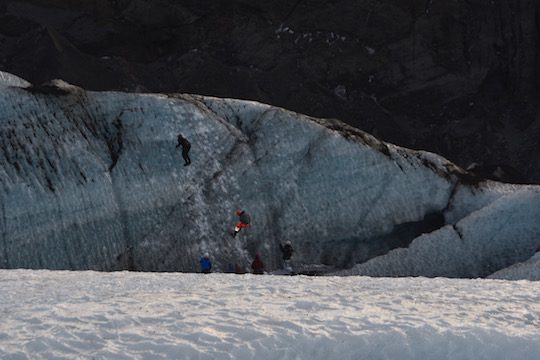Guilty Pleasures, Iceland Edition

Apologies for my absence for a while, but I spent the past four days in Iceland, one of my wife’s favorite places on earth, celebrating our twentieth wedding anniversary. We had a delightful time, traveling by super-jeep into the interior to visit the sanctuary of Landmannalaugar, hiking across a glacier, soaking in the ubiquitous geothermally-heated pools, and generally relaxing. The only thing we didn’t do that we hoped to was see the northern lights — they’re temperamental performers, and they didn’t feel like showing off for us I guess.
It’s a wonderful place, like nowhere else I’ve been — and I would encourage everyone to go and see it for themselves.
But I’m not sure I should.
When we were last in Iceland, in 2009, on a longer trip, the country was already on the tourist map. my wife remarked at the time on how much the country had changed since she had first been there in 1980, when there was virtually no tourist industry to speak of. But nonetheless, it still felt like a land ripe for discovery. We were there in late June and July, tourist season, and yet there were plenty of times that we felt like the only people there.
This year, an estimated 1,500,000 people will visit Iceland. That’s five tourists for every native — and a threefold increase in traffic since our last visit. Over a third of Iceland’s export dollars are now derived from tourism, outpacing both fishing and aluminum smelting. The country is building hotels as fast as they possibly can, and the employment mix is changing rapidly. Iceland’s natural beauty is not yet in danger of being displaced (not by tourism anyway; climate change is another matter), because the sheer scale of the country can absorb large numbers of visitors. But the country’s culture and way of life is another matter. If the tourist boom sustains itself, Iceland may cease to be a place unto itself, and instead become a place dedicated to self-representation to outsiders. If the boom ends abruptly, Iceland will face a very painful economic adjustment.
I do want to stress that the rustic old Iceland is still very much present outside of Reykjavik. The week we were there, we were the only two people crazy enough to schlep across the frozen wastes to Landmannalaugar; we had its hot springs entirely to ourselves. The ferry from Norway to Seyðisfjörður has not seen the massive increase in traffic that Keflavik airport has. But our guide on the glacier hike told us that only a few years ago they’d have one or two groups a day during the summer, and now, in November, we passed over a dozen other groups tramping across the ice. (And the ice is melting so quickly now that it will likely be gone in 20 years.)
So I’m torn. I want everyone to have a share in the beauty and sublimity of this very special place. But everyone is too many. And rationing access would turn Iceland into a playground for the wealthy (which is also already happening).
I’ve perseverated on this subject before, from the opposite direction, wondering about whether acting to preserve the experience of the kind of tourist who “gets it right” from my perspective impinges unreasonably on the experience of people who really live in the world that people like me are just visiting. Now I’m worrying about whether not acting to preserve that experience, and to limit it to a reasonable number, inevitably transforms the world being visited beyond recognition.
I wish I knew the answer.
Comments